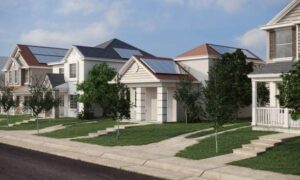As the world grapples with making the clean energy transition, South Australia shows it can be done.
Solar power is already generating most – and sometimes all – of the state’s electricity demand. For quality solar Adelaide, check out renewable solar Adelaide now.
Solar Panels
Solar panels convert sunlight into electricity, then feed it to your power grid. This can save households thousands of dollars annually, offsetting rising electricity prices and providing a regular income from the feed-in tariff (depending on your energy retailer and state).
Solar panel systems, including tile and metal, can be installed on most roof types. However, the aspect and tilt of your roof are essential. Ideally, panels should be north-facing, with a minimum 30-degree pitch.

Households can maximise their solar savings by consuming the electricity their system generates daily. This can be accomplished by setting appliances such as air conditioners and pool pumps to operate during the sunniest parts of the day. Solar households in Adelaide can also benefit from daylight savings, with the sun not setting until 8:30 pm during most of the summer. This can be helpful for those who consume high amounts of energy during the afternoon.
Solar Hot Water
Solar hot water (SWH) systems are an easy and cost-effective way for households to reduce their fossil fuel demand, helping to keep electricity prices low and cutting greenhouse gas emissions. They are often paired with backup electric or gas heaters to ensure that there is always sufficient heating capacity for household hot water needs. For quality solar Adelaide, check out renewable solar Adelaide now.
New technology is improving the performance and usability of solar water heaters, including intelligent control systems that optimise energy utilisation and remote monitoring capabilities. They also offer better durability and longer system lifespans.
Active direct systems are the most common type of SWH systems. They pump potable water directly from the solar collector to a storage tank for domestic use. They are best suited to mild climates. Active indirect systems use a heat-transfer fluid (usually a mixture of water and antifreeze) to circulate water between the collectors, the storage tank, and the home. This type of system is more suitable for freezing climates as the heat-transfer fluid can be chosen for its freeze-resistant properties.
Battery Storage
Powered by solar panels and battery storage, the system can run for days without drawing on electricity from the grid. This can help to protect your home from future blackouts and provide a step towards energy self-sufficiency.
South Australia has achieved a world-leading share of renewable energy in its electricity supply, with the state regularly reaching over 100 per cent renewables thanks to large-scale wind and rooftop solar. On Sunday, October 11, a remarkable milestone was achieved when AEMO allowed more than 23 per cent of the state’s power demand to be met by renewables alone. For quality solar Adelaide, check out renewable solar Adelaide now.
Energy Efficiency
Energy efficiency is a crucial way to reduce building electricity costs. For example, the City of Adelaide offers a range of incentives for businesses and residents to make their buildings more efficient.
As a result of the city’s energy efficiency efforts, it can now meet all its energy needs with renewable energy. This includes powering the Adelaide Aquatic Centre, UParks and depots, and the historic Adelaide Town Hall. This has saved the City of Adelaide over a quarter of a million dollars annually.
The city is also working to become Australia’s first carbon-neutral city. This involves reducing the city’s emissions through energy-efficient buildings and electric vehicles and generating power from wastewater treatment plants. This is expected to save the city up to $3.6 million in energy costs and help make Adelaide greener. It will also make Adelaide more resilient in the face of climate change impacts like heatwaves and drought.
